#Autofocus USB camera
Explore tagged Tumblr posts
Text
Autofocus USB Camera: Advanced Imaging with Vadzo Imaging
In the world of modern imaging technology, an autofocus USB camera plays a crucial role in delivering high-quality visuals with precision and clarity. These cameras are widely used across various industries, including industrial automation, healthcare, security, and robotics. Vadzo Imaging, a leading name in the industry, offers advanced autofocus USB cameras designed to meet diverse imaging needs.

Why Choose an Autofocus USB Camera?
An autofocus USB camera provides superior image clarity by automatically adjusting the focus based on the distance of the subject. Unlike fixed-focus cameras, which require manual adjustments, autofocus technology enhances convenience and ensures crisp images without user intervention. This feature is particularly beneficial for applications where objects vary in distance, such as industrial inspections, telemedicine, and smart surveillance.
USB3.2 Camera: Enhanced Speed and Performance
Vadzo Imaging integrates cutting-edge USB3.2 camera technology into its autofocus cameras, ensuring faster data transfer rates, reduced latency, and improved overall performance. The USB3.2 interface allows seamless connectivity, making these cameras ideal for high-speed imaging applications. Whether used in machine vision, video conferencing, or laboratory research, Vadzo Imaging’s USB3.2 autofocus cameras provide unparalleled efficiency and reliability.
Key Features of Vadzo Imaging’s Autofocus USB Cameras
High-Resolution Imaging – Captures detailed images with advanced autofocus functionality.
USB3.2 Interface – Offers fast and stable data transmission for real-time imaging.
Plug-and-Play Connectivity – Compatible with multiple operating systems for easy integration.
Compact and Durable Design – Suitable for industrial and professional applications.
AI-Driven Autofocus – Adapts focus dynamically for optimal image quality in changing environments.
Applications of Autofocus USB Cameras
Industrial Automation: Enhances accuracy in manufacturing and quality control processes.
Medical Imaging: Supports telemedicine and diagnostic applications with high-resolution visuals.
Security & Surveillance: Provides clear and detailed monitoring for enhanced safety.
Robotics & AI: Facilitates machine learning and automation applications requiring dynamic focus adjustments.
Live Streaming & Video Conferencing: Ensures professional-grade video quality in real-time communication.
Conclusion
Vadzo Imaging’s autofocus USB camera with USB3.2 camera technology is a powerful tool for professionals seeking precision and efficiency in imaging applications. With its advanced features and superior performance, this camera is an excellent choice for industries requiring high-quality visuals. Upgrade to Vadzo Imaging’s autofocus USB cameras today and experience the future of imaging technology!
1 note
·
View note
Text
Why Are Smart Cities Switching to USB Camera Networks?

Imagine a bustling smart city where every movement is tracked seamlessly, traffic flows smoothly, and public spaces are safer than ever. But what powers this level of precision and connectivity? It’s not just advanced algorithms or sensors—it’s the humble yet powerful USB camera network.
Cities worldwide are facing challenges like rising urban populations, traffic congestion, and security risks. Traditional surveillance systems often fail to keep up, leaving gaps in data and coverage. Enter the Autofocus USB camera, a modern solution tailored to meet the demands of smart city ecosystems.
Why are these cameras becoming the go-to choice for urban planners? Let’s delve into the reasons.
The Customer's Pain Point: Challenges in Urban Surveillance
Smart cities rely on real-time data to make informed decisions, but the current infrastructure presents some significant challenges:
Limited Image Clarity: Conventional cameras struggle with capturing clear images in dynamic environments. Think of poorly lit streets, fast-moving traffic, or extreme weather conditions.
Scalability Issues: Expanding traditional surveillance systems often requires expensive hardware and complex installations, making scalability a pain point for growing cities.
Manual Adjustments: Static-focus cameras require constant manual tweaks, which is both time-consuming and inefficient in a city-wide network.
Data Integration Gaps: Many existing systems don’t integrate well with modern IoT frameworks, limiting their utility in a connected urban ecosystem.
The Autofocus USB Camera Advantage
Smart cities need smart solutions, and Autofocus USB cameras deliver on multiple fronts:
1. Precision in Dynamic Environments
Autofocus USB cameras automatically adjust to changes in distance, ensuring sharp and clear images whether it’s a speeding vehicle or a pedestrian walking past. This eliminates the need for constant manual adjustments, providing consistent performance in real-time.
2. Plug-and-Play Simplicity
Unlike traditional systems, USB cameras are easy to install and integrate. Their plug-and-play design ensures they can be connected to existing networks without extensive modifications, saving time and reducing costs.
3. Seamless Integration with IoT
Smart cities thrive on connectivity. Autofocus USB cameras can easily connect to IoT platforms, enabling real-time data sharing and analysis. This integration enhances their utility in traffic management, security monitoring, and even environmental sensing.
4. Scalability and Cost Efficiency
Need to expand your surveillance coverage? USB cameras are a scalable solution. Their affordability and minimal installation requirements make it easy for cities to deploy them across new areas without breaking the bank.
5. Enhanced Low-Light Performance
Modern autofocus USB cameras often come equipped with low-light and HDR capabilities, ensuring clear visibility even in poorly lit areas. This is crucial for improving nighttime security in urban spaces.
Applications in Smart Cities
The versatility of autofocus USB cameras makes them an invaluable tool for various urban applications:
1. Traffic Management
Monitor and analyze real-time traffic flow.
Identify congestion points and implement dynamic signal adjustments.
Capture violations like speeding or running red lights with precision.
2. Public Safety
Enhance surveillance in high-traffic public areas like parks and transit hubs.
Quickly identify and respond to incidents through integrated AI-based analytics.
3. Infrastructure Monitoring
Inspect roads, bridges, and other critical infrastructure.
Use high-resolution imaging to identify wear and tear or potential hazards.
4. Environmental Monitoring
Track pollution levels or monitor weather patterns through visual data.
Integrate with other IoT devices for a holistic approach to environmental management.
Why Autofocus USB Cameras Solve Customer Pain Points
From Inconsistent Surveillance to Reliable Monitoring
With autofocus USB cameras, cities no longer need to compromise on image quality. The ability to adjust focus automatically ensures that every detail is captured accurately, regardless of the environment.
Affordable Solutions for Tight Budgets
Urban planners often face budget constraints. The cost-effectiveness of USB camera networks allows cities to scale their systems without stretching financial resources.
Eliminating Manual Hassles
The automated functionality of these cameras reduces the need for human intervention, saving time and operational costs.
Future-Proofing Urban Infrastructure
As cities become smarter, the need for adaptable and IoT-ready technologies grows. Autofocus USB cameras are built to meet these future demands, ensuring a long-term return on investment.
How to Transition to USB Camera Networks
Switching to USB camera networks is a straightforward process:
Assess Your Needs: Evaluate the areas and applications where you require surveillance.
Choose the Right Cameras: Select autofocus USB cameras that align with your requirements for resolution, lighting, and connectivity.
Integrate with IoT Platforms: Work with tech providers to integrate cameras into existing smart city systems.
Optimize and Scale: Start small and expand based on the data and insights generated.
Unlock the Potential of Smart Surveillance
Smart cities need smart eyes—and Autofocus USB cameras are precisely that. With their ability to adapt, integrate, and deliver unparalleled performance, they’re the ideal solution for modern urban challenges.
Ready to take your city’s surveillance to the next level? Discover how autofocus USB cameras can revolutionize your infrastructure.
Explore cutting-edge Autofocus USB camera solutions today. Visit Vadzo Imaging to find the perfect fit for your smart city projects.
0 notes
Text
Autofocus USB Cameras: Precision Focus for Telematics and Smart City Solutions

Accuracy and precision are more important than ever in the quickly evolving field of technology today, particularly in fields like telematics and smart city solutions. With the precision required to promote efficiency, safety, and creativity in various domains, autofocus USB cameras are quickly becoming a game-changing instrument. These cameras provide automated focus changes that guarantee optimal clarity in a variety of settings, whether they are being used for traffic monitoring, supporting telematics systems, or improving surveillance. Let's examine the ways in which these cameras are significantly influencing the infrastructure of smart cities and telematics.
Enhanced Traffic Monitoring with Autofocus USB Cameras
Accurate traffic monitoring is a cornerstone of smart city development. Autofocus USB Cameras for traffic systems help ensure that monitoring equipment captures crisp, clear footage in all conditions. The automatic focus capabilities adjust quickly to changing distances, such as vehicles moving closer or farther from the camera, ensuring that no detail is missed. This level of precision can aid in traffic flow analysis, reduce congestion, and enhance safety by detecting incidents in real time. With the ability to adjust focus on the fly, these cameras are integral to intelligent traffic management systems.
Telematics Systems Powered by Autofocus USB Cameras
Telematics systems rely heavily on high-quality visual data to track, monitor, and analyze vehicle behavior. Autofocus USB Cameras for telematics solutions offer the clarity needed to capture precise details, regardless of environmental changes. As vehicles move through different lighting conditions or distances, the autofocus feature ensures sharp, detailed images. This can improve the accuracy of driver monitoring systems, collision detection technologies, and overall fleet management. The camera’s ability to adapt to dynamic scenarios in telematics applications makes it a key component in improving operational efficiency and safety.
Smart Surveillance with Autofocus USB Cameras
Smart surveillance is becoming a vital aspect of smart cities, and autofocus USB cameras for surveillance systems offer the flexibility needed for effective monitoring. These cameras can adjust focus automatically when people or objects move within the frame, making them ideal for dynamic environments such as public spaces, transportation hubs, or perimeter security areas. This functionality enhances security by ensuring that important details, such as facial features or vehicle plates, are captured clearly, even in fluctuating conditions. The adaptability of autofocus cameras can drastically improve the efficiency of smart surveillance systems.
Supporting Environmental Monitoring and Compliance
Environmental monitoring is another critical aspect of smart city infrastructure. Autofocus USB Cameras for environmental monitoring allow cities to capture and analyze data about air quality, waste management, and water levels with high precision. The autofocus feature ensures that cameras can capture details across varying distances and environments without manual adjustments, allowing for more accurate data collection. These cameras are instrumental in maintaining compliance with environmental regulations and promoting sustainable urban development.
Driving Innovation in Smart Toll Collection
Automating toll collection systems is a key initiative in many smart city projects, and autofocus USB cameras in tolling systems provide the technological edge needed for precision tracking and payment processing. These cameras can seamlessly adjust to different vehicle sizes and speeds, ensuring that accurate images are captured for license plate recognition and toll calculations. This reduces the need for manual intervention, speeds up the toll collection process, and enhances the efficiency of urban transportation networks.
The Versatility of Autofocus USB Cameras in Telematics and Smart City Solutions
As demonstrated in these applications, the versatility of autofocus USB cameras is undeniable. From telematics and fleet management to traffic monitoring and environmental compliance, these cameras offer the precision, adaptability, and automation needed to support the growing demands of smart city infrastructure. Their ability to adjust focus in real time ensures that critical details are always captured, driving efficiency and improving safety across multiple systems.
Take Your Telematics and Smart City Solutions to the Next Level
Autofocus USB cameras are transforming the way telematics and smart city solutions are developed and implemented. With their ability to provide crystal-clear focus in any environment, they are an essential tool for building smarter, safer, and more efficient cities. Explore how autofocus USB camera technology can enhance your telematics systems or contribute to the success of your smart city project. Reach out today to learn more or subscribe for the latest insights on camera technology advancements.
0 notes
Text
Lenovo Idea Tab Pro
The Lenovo Idea Tab Pro, unveiled in March 2025, is a versatile 12.7-inch tablet designed to cater to both students and everyday users. It combines robust performance with user-friendly features, making it a compelling choice in the tablet market.
Design and Display
The Idea Tab Pro boasts a sleek and lightweight design, measuring 291.8 x 189.1 x 6.9 mm and weighing approximately 620 grams. Its 12.7-inch IPS LCD screen offers a resolution of 2944 x 1840 pixels, delivering crisp and vibrant visuals. The display supports a 144Hz refresh rate and HDR10, enhancing the viewing experience with smoother transitions and richer colors. An optional anti-reflection coating is available to reduce glare, improving usability in various lighting conditions.
Performance
At its core, the Idea Tab Pro is powered by the MediaTek Dimensity 8300 chipset, featuring an octa-core CPU configuration: one Cortex-A715 core at 3.35 GHz, three Cortex-A715 cores at 3.2 GHz, and four Cortex-A510 cores at 2.2 GHz. This setup ensures efficient multitasking and smooth performance across applications. The tablet comes equipped with 8GB of LPDDR5X RAM and offers storage options of 128GB (UFS 3.1) or 256GB (UFS 4.0), providing ample space for apps, media, and documents.
Camera Capabilities
For photography and video calls, the Idea Tab Pro features a 13 MP rear camera with autofocus and LED flash, capable of recording 1080p videos. The front-facing 8 MP camera is suitable for selfies and virtual meetings, also supporting 1080p video recording.
Audio and Multimedia
Audio quality is a highlight, with the tablet housing four JBL stereo speakers that support 24-bit/192kHz Hi-Res audio. This setup ensures an immersive sound experience, whether you're watching movies, listening to music, or participating in video conferences.
Battery Life and Charging
The device is equipped with a substantial 10,200 mAh Li-Po battery, supporting 45W wired charging. This large battery capacity ensures extended usage, making it reliable for all-day activities without frequent recharging.
Operating System and AI Features
Running on Android 14, the Idea Tab Pro integrates advanced AI capabilities through Google Gemini and features like Circle to Search with Google. These tools enhance user interaction, providing intuitive and efficient ways to access information and perform tasks.
Connectivity and Additional Features
Connectivity options include Wi-Fi 802.11 a/b/g/n/ac/6e, Bluetooth 5.3, and USB Type-C 3.2 with DisplayPort support. The tablet also features a side-mounted fingerprint sensor integrated into the power button for secure and convenient access. Stylus support is available, catering to users interested in drawing or note-taking.
Pricing and Availability
The Lenovo Idea Tab Pro is available in various configurations:
8GB RAM with 128GB storage, including a pen, priced at
8GB RAM with 256GB storage, including a pen, priced at
12GB RAM with 256GB storage, without accessories, priced at
Additional bundles with accessories like a folio case are available at varying price points. Prospective buyers should verify the included accessories with retailers to ensure clarity.
Conclusion
The Lenovo Idea Tab Pro stands out as a well-rounded tablet, offering a blend of performance, display quality, and user-centric features. Its integration of AI capabilities and support for accessories like a stylus and keyboard pack make it a versatile tool for both educational and everyday use.
#Lenovo Idea Tab Pro#Lenovo Idea Tab Pro price#Lenovo Idea Tab Pro price in bamgladesh#Lenovo Idea Tab Pro bangladesh
3 notes
·
View notes
Text
Sony RX100 VII Thoughts After Two Months
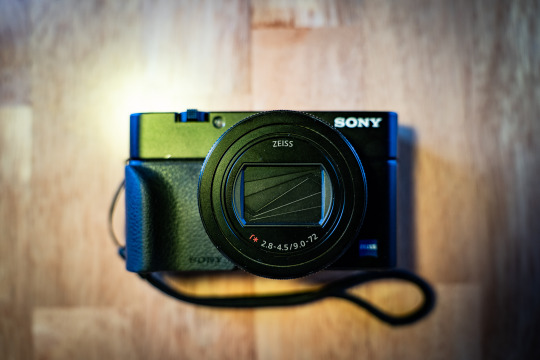
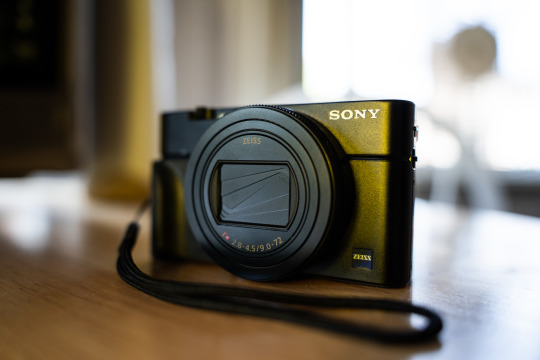
PROS:
Stacked sensors are the future. Well, technically the present considering that Canon, Nikon, Sony, Fuji, and OM Systems all use stacked sensors in their top of the line cameras. Either way, finally getting to experience shooting with one on a daily basis has made me want one in pretty much any camera going forward. The benefits are twofold: Not only do you get shutter speeds up to 20 frames per second, and without a mechanical shutter flipping in the way obscuring your view in between shots, but you also get no rolling shutter while doing it. Pretty much every Sony camera can shoot 10 fps bursts with the silent shutter, but any movement can give you a jello-like effect since the sensor reads out so slow on non-stacked cameras. The only con, at least on this camera, is that you can’t shoot flash at higher than 1/100 with the electronic shutter. That’s still plenty fast for a lot of stuff, but well below the 1/2000 you get when shooting the mechanical shutter.
The fast frame rate wouldn’t make much of a difference if the camera was bad at autofocusing, but this camera is great at it. It has a lot of the same fancy focusing stuff that my full frame Sony has like human/animal eye autofocus and all the tracking modes I’m used to. It actually makes the camera pretty solid for wildlife if you can get close enough at the 200mm end.
Speaking of that, the 24-200mm equivalent is a great range, and one that I missed a lot since I traded away my Tamron 28-200 to help cover the cost of my A7RIV. The small size and extra 4mm on the wide end actually makes it even more convenient than that Tamron.
Aside from covering a broader range than the 24-70 equivalent lens from the older RX100 cameras, this lens also seems noticeably sharper. The last RX100 model I had, the Mk. IV, just didn’t seem as crispy as this lens is.
It has a touchscreen! It’s wild to think that the previous RX100 cameras I owned didn’t have this basic ass feature, but Sony was very late in putting touch screens in their cameras. Ironically, I don’t really use it in this one because the AF is good enough that I can just do focus and recompose with tracking.
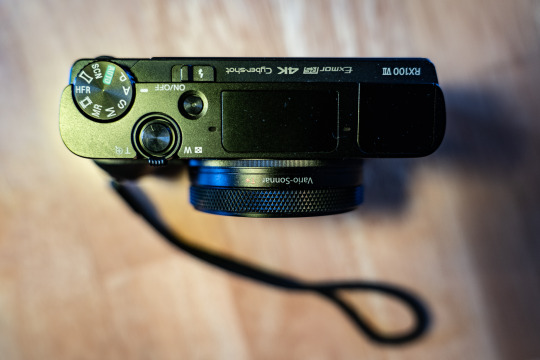
CONS:
It’s still only a 1” style sensor so high ISO isn’t the cameras strong suit. Programs like DXO PureRAW help a lot and let you get somewhat usable images at ISO 6400 in a pinch, but you’re kinda pushing things at that point.
While the lens is sharper and covers a wider range than the older models, it’s also significantly slower. At 24mm equivalent it’s already at f/2.8 where the old cameras were f/1.8. It’s f/3.2 at 25mm, f/3.5 at 33mm, and f/4 at 40mm. From 109mm to 200mm you’re at f/4.5. The relative slowness of the lens combined with the small sensor means that this can struggle getting quality images in low light without a tripod or something.
No USB-C. My Fuji, Ricoh, and larger Sony all have USB-C charging, which is amazingly convenient when traveling. I haven’t really gone anywhere with this camera yet, but having to account for a micro USB cable is annoying since pretty much everything aside from my iPhone uses USB-C.
It’s expensive. Just like my Mk III and Mk IV I got it used so it was cheaper than retail, but the copy I got cost about twice what I paid for the previous models.
Start up time is just a tad bit slower than I’d like. The GRIII and X100V both beat it that regards, albeit those aren’t zoom lens so I have to cut the Sony some slack.
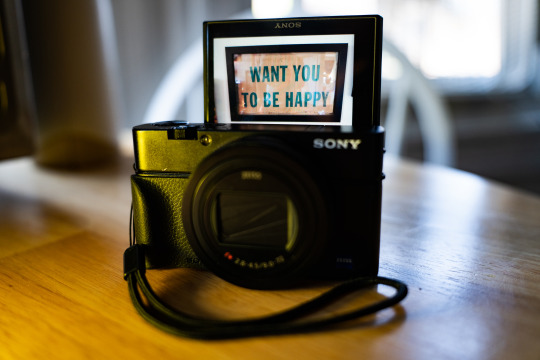
SAMPLE PHOTOS:
(The sample photos were edited in Lightroom Classic and DXO PureRAW2. Also, the sensor creates a roughly 2.7x crop factor, so the 9-72mm lens equates to 24-200ish)

Young Bird | ISO 160. 72mm. f/4.5. 1/200.

Graffiti Shot from a Car | ISO 100. 33.98mm. f/4. 1/400.
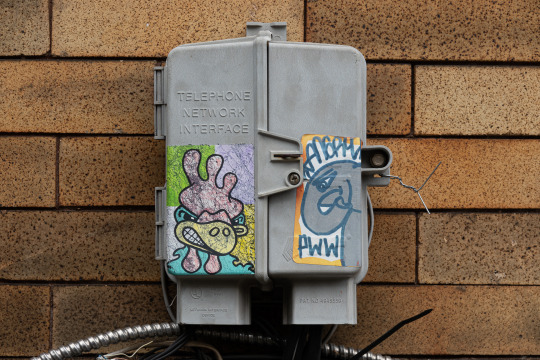
Stickers | ISO 100. 29.67mm. f/4.5. 1/100.

City Hall | ISO 100. 38.13mm. f/4.5. 1/200.

Flip Up Screen Selfie with My Friend Hanae | ISO 3200. 9mm. f/2.8. 1/40.

Zoomed in Graffiti | ISO 640. 72mm. f/4.5. 1/500.

Fishing Store Neon | ISO 800. 28.67mm. f/8. 1/200.

Flowers | ISO 200. 72mm. f/5. 1/640.

Selfie Shots with My Sister | ISO 3200. 9mm. f/2.8. 1/100.
33 notes
·
View notes
Text
Spring Into Live Production with Videoguy's Top Products for Outdoor E - Videoguys
New Post has been published on https://thedigitalinsider.com/spring-into-live-production-with-videoguys-top-products-for-outdoor-e-videoguys/
Spring Into Live Production with Videoguy's Top Products for Outdoor E - Videoguys


Boost your outdoor event success with Videoguys’ top live production gearperfect for streaming, recording, and capturing every moment this spring. Discover reliable, high-performance tools ideal for festivals, sports, and live shows in any outdoor setting.
Watch the full video below:
youtube
LiveU Solo Pro
Rock-Solid Reliability: Up to 4 external 4G modems
Limitless Coverage: Capture footage from anywhere
Exceptional Quality: 4K video resultion
Cost-Effective Transmission: HEVC encoding
LiveU Lightweight Production Bundles
Pay as you go or Yearly plan that includes the hardware encoder, data, and access to LiveU Studios cloud-based switching platform.
LU300S or LU800 + Data Including LRT + LiveU Studio
Learn more about LiveU Lightweight Production Bundles HERE
Kiloview P3 mini
4G Wireless Bonding Encoder
Easy outdoor streaming anytime, anywhere
On-board modems included
Perfect outdoor live streaming
Kiloview P3
Up to 6-channel Connections Bonding
4Kz HDMI+3G-SDI with H.265 & H.264 Encoding
NDI | HX, RTMP, SRT, RTSP, HLS
4.3-inch Touch LCD Screen
Dual Battery Module
Pro-Level Video Processing
Reliable Recording and Streaming
KiloLink Server – Safe and flexible bonding software
Kiloview P3 + Modems Bundles Available
YoloLiv YoloBox Family
The ultimate all-in-one portable mulit-cam live streaming & streaming system to stream from anywhere to everywhere
Resolution
Up to 4K30
Up to 4K60
Brightness
1,000 nits
3 in, 1 out
4 in, 1 out
8 in, 2 out
3 in, 1 out
6 in, 2 out
ISO Recording
Up to 5 channels at 1080 60p
Up to 4 channels at 4k 30
Multi-Cam NDI Sports Live Production Bundle
Ready to take your sports productions to the next level? This powerful bundle includes everything you need from PTZOptics, NETGEAR, and YoloLiv to give you a complete NDI-ready 3-camera solution perfect for streaming and recording live sports events.
Whats Included:
1 x PTZOptics Move 4K 12x
2 x PTZOptics Studio 4K 12x
1 x PTZOptics SuperJoy
1 x YoloLiv YoloBox Ultra
($99 NDI License Available directly from YoloLiv)
1 x NETGEAR 10PT M4250-8G2XF-POE+ Managed Switch
BirdDog A300 Outdoor PTZ Camera
IP67 Extreme Weatherproof
30x Optical Zoom
Full NDI
1 / 2.8″ CMOS 2.13MP Sensor
NDI and SDI outputs
1080p60
Canon Outdoor PTZ Cameras
Optical Zoom
20x Zoom with Optical Image Stabilization
15x Zoom with Optical Image Stabilization
Resolution
4K30 and 1080p60
1/2.3″ CMOS with Hybrid Auto Focus
1″ CMOS Sensor with Dual Pixel Autofocus
6G-SDI, HDMI, and IP Video Out
12G-SDI Video Out
Outdoor Rating
Outdoor Camera with Wiper (IP65 Rated)
Outdoor Camera with Wiper (IP55 Rated)
Canon Color Science
Panasonic Connect AW-UR100 Outdoor PTZ Camera
Compatible with 4K/60p shooting
Built-in cropping function
24x optical zoom/74.1° horizontal
Three types of image stabilization, OIS, EIS, and D.I.S.S.
Durability to withstand the harshest of environments
Western Digital ArmorATD Storage
Rugged Durability For Out In the Field
Thunderbolt 3, USB 3.2 Gen 1
Throughput: 130 MB/s read transfer
Rugged: IP54 rain/dust rating with crush resistance of 1,000 lbs
Pixellot AIR NXT
Portable AI Sports Camera
Pro-Quality Streaming with 4K video and stereo audio
AI-Automated Highlights for multiple sports
Multiple Viewing Modes: broadcast, panorama, tactical
Fast Uploads via Wi-Fi or 4G/5G
13-Hour Storage with USB-C rapid charging
Lightweight & Durable for all-weather use
Atomos Monitors and Recorders
5-inch, 1000nit HDR Monitor-Recorder for DSLR and Mirrorless Cameras 5-inch, 1000nit HDR Monitor-Recorder for Mirrorless and Cinematic Cameras 7″ Monitor and Recorder 7-inch HDR Monitor-Recorder 8K RAW SUMO19SE bundle with ZATO Connect, Z-Mount, and Sunhood with over $700 worth of savings!
#000#4g#4K#5G#6G#8K#ai#air#amp#Atomos#audio#battery#board#bundle#Cameras#Canon#Capture#channel#Cloud#Color#data#DSLR#dust#easy#event#Events#festivals#focus#Full#Hardware
0 notes
Text
REVIEW
iPhone 16 128 GB: 5G Mobile Phone with Camera Control, A18 Chip and a Big Boost in Battery Life. Works with AirPods; Black
📱 iPhone 16 (128GB, Black) – Review
The iPhone 16 introduces notable enhancements over its predecessor, including the powerful A18 chip, improved battery life, and innovative camera functionalities. It offers a blend of performance and features suitable for a wide range of users.
✅ Pros:
• Performance & AI Capabilities: Equipped with the A18 chip, the iPhone 16 delivers a 30% performance boost over the iPhone 15, ensuring smooth multitasking and gaming experiences. The enhanced Neural Engine supports advanced AI features, making the device future-ready.
• Camera Enhancements: The 48MP main camera, combined with a 12MP ultra-wide lens featuring autofocus, allows for high-quality photos, including macro shots. The new Camera Control button offers intuitive access to camera functions, enhancing the photography experience.
• Battery Life: With up to 22 hours of video playback, the iPhone 16 ensures all-day usage. It supports faster wired and wireless charging, reaching 50% charge in approximately 30 minutes with a 20W adapter.
• Design & Build: The device boasts a sleek design with a new vertical camera layout and a durable second-generation Ceramic Shield front cover. It's also water-resistant up to 6 meters for 30 minutes.
• Audio Quality: Stereo speakers with spatial audio provide an immersive sound experience, enhancing media consumption and gaming.

❌ Cons:
• Display Limitations: The 6.1-inch OLED display retains a 60Hz refresh rate, lacking the smoother experience offered by higher refresh rates found in competitors and Pro models.
• Charging Speed: While improved, the charging speed is still behind some competitors, with a full charge taking around 80 minutes.
• No Telephoto Lens: The absence of a dedicated telephoto lens limits optical zoom capabilities, which might be a drawback for photography enthusiasts.
• No Expandable Storage: The iPhone 16 does not support microSD cards, so users must choose their storage capacity wisely at the time of purchase.
• USB-C Port Limitations: Despite adopting the USB-C standard, the port operates at USB 2.0 speeds, restricting data transfer rates.
Click to Official Link
The A18 chip in the iPhone 16 introduces several standout features that make it a significant leap over its predecessors. Here’s what sets it apart:
• 3nm+ Architecture: It’s built on an enhanced 3-nanometer process (sometimes referred to as 3nm+), which delivers better performance and energy efficiency compared to the A17. This directly contributes to improved battery life and reduced heat generation.
• 30% Faster CPU and GPU: Benchmarks indicate approximately 30% improvement in both CPU and GPU performance compared to the A17 Pro, making tasks like gaming, multitasking, and video editing notably smoother.
• Next-Gen Neural Engine (32-core): The upgraded Neural Engine handles up to 60 trillion operations per second, which boosts AI-related tasks like real-time language translation, image processing, and on-device machine learning tasks (including Apple Intelligence features) with remarkable speed and accuracy.
• Advanced Image Signal Processor (ISP): The ISP improvements help enhance photo quality, particularly in low light, enable real-time semantic rendering (where the phone recognizes scene elements for better processing), and improve video recording with smarter HDR.
• Hardware-Accelerated Ray Tracing: Like in the A17 Pro, but faster — the A18 boosts real-time ray tracing in games, offering console-like graphics with richer lighting, shadows, and reflections.
• Dynamic Power Management: The chip intelligently balances performance and efficiency cores to maximize battery life during routine tasks without sacrificing responsiveness.
In short — it’s not just faster, but smarter and more efficient, with a clear focus on AI, graphics, and battery life enhancements.
🧾 Conclusion:
The iPhone 16 128GB in Black offers a compelling package for users seeking a balance between performance, camera capabilities, and battery life. While it lacks some premium features like a high-refresh-rate display and telephoto lens, its strengths in processing power, photography, and design make it a worthy upgrade for many. However, those desiring top-tier display and camera features might consider the Pro variants.
Click to Official Link
To know, Review of other products mail to [email protected]

0 notes
Text
Price: [price_with_discount] (as of [price_update_date] - Details) [ad_1] From the manufacturer [Joy in Every Beat] Octa JBL Hi-Fi Speakers (sound by JBL), 4 x tweeters, 4 x force-balanced bass units with Dolby Atmos [Outstanding Display] 11.5 Inch, 2K Display with 90 Hz Refresh Rate [Never miss a beat] 8600 mAh Battery with 45 W Fast Charger available in the box [Seamless Experience] Android 14 with upgrades until Android 16, and security patches available until June 2028 [Processor] Mediatek Helio G99 Octa Processor [Ports] 1 USB-C Port, 1 3.5 mm port for headphone/microphone, 1 microSD card slot [Camera] Front 8.0 MP with Face Unlock, Rear 8.0 MP with Autofocus [Care for You] TÜV Rheinland Full Care Display 2.0 Certification, IP52 Certified for Dust & Water Resistance [ad_2]
0 notes
Text
Is Your Camera Housing Adequate for Your Environment?

When selecting an autofocus USB camera for a particular application, the housing may be the last thing on your mind. But have you ever wondered if your camera’s performance could be jeopardized by its surroundings? Or, are you worried about your camera's durability in extreme conditions? The truth is, camera housing is more critical than most realize, especially in environments where factors like moisture, dust, temperature fluctuations, and impacts come into play. Investing in the right camera housing isn’t just about extending the life of your device—it’s about ensuring reliable, high-quality imaging that meets the demands of your application.
This guide will explore the essential elements of camera housing, focusing on how these protective enclosures can impact the longevity and effectiveness of an autofocus USB camera in various environments. We’ll cover the potential pain points of inadequate housing and provide actionable insights to help you choose a camera solution that withstands environmental challenges.
Why Camera Housing Matters for an Autofocus USB Camera
When deployed in different industries, an autofocus USB camera can face a broad range of environmental factors that threaten its performance. From manufacturing floors to outdoor kiosks, a camera’s success hinges on its ability to withstand environmental wear and tear. Key considerations include:
Temperature Variations Environments that experience drastic temperature shifts, such as outdoor or industrial spaces, can negatively impact camera components. Extreme cold can cause the camera lens to fog, whereas excessive heat can degrade the camera’s electronics over time. High-quality housings with proper insulation, ventilation, and sometimes even cooling elements help to keep internal components at an optimal temperature, ensuring that your autofocus USB camera maintains clear, stable images.
Moisture Resistance Humidity, rain, and other moisture sources can be harmful to any electronic device, including cameras. In environments where moisture is inevitable, cameras require sealed, waterproof housings that prevent condensation and corrosion. Waterproof ratings, such as IP66 or IP67, indicate that a housing is designed to protect against heavy rain or even submersion, critical for outdoor applications where exposure to water is unavoidable.
Dust and Particle Protection On manufacturing floors or in agriculture settings, dust and airborne particles can quickly accumulate on camera components, affecting image clarity and causing malfunctions. Housings with a high Ingress Protection (IP) rating protect against dust and other particulates, keeping the internal autofocus USB camera free from contaminants that can impair its performance.
Impact Resistance Many industrial settings expose cameras to vibrations, jolts, and even accidental impacts. A sturdy, shockproof housing with reinforced materials can absorb these forces, protecting the sensitive optics and electronics of your autofocus USB camera from damage. This is especially critical in automotive and heavy-duty applications where constant movement is a factor.
Security Concerns In applications such as surveillance, camera tampering is a concern. Durable housings equipped with tamper-proof features can deter vandalism or unauthorized access. Whether it’s a camera in a public space or a secure facility, choosing robust housing can ensure your camera’s safety and functionality.
The Risks of Ignoring Camera Housing
If housing quality is overlooked, a range of issues can arise:
Foggy or Distorted Images: Inadequate protection from temperature changes and moisture often leads to condensation on the lens, resulting in unclear images.
Frequent Repairs and Replacements: Cameras exposed to dust and debris can quickly wear out, leading to high maintenance costs and downtime.
Unreliable Performance: Without proper housing, the autofocus feature of USB cameras may fail to work accurately, affecting the quality and reliability of images.
Unexpected Costs: Damages due to environmental factors can lead to expensive repairs or replacements, costs that could have been avoided with the right housing.
Camera Housing Materials: What to Look For
To ensure your autofocus USB camera withstands harsh conditions, consider the following materials for your housing:
Stainless Steel: Known for its durability, stainless steel is ideal for environments where chemical exposure and corrosion are concerns.
Polycarbonate: This impact-resistant material offers high clarity, making it perfect for cameras requiring an unobstructed view, like security cameras.
Aluminum: Lightweight yet strong, aluminum provides a good balance of durability and affordability, suitable for many indoor and outdoor applications.
Common Housing Types for Autofocus USB Cameras
There are several types of camera housings that you can select based on your specific environment:
Standard Enclosures Best suited for controlled indoor environments, these housings offer minimal environmental protection. Standard enclosures are affordable and ideal for applications with limited exposure to dust or moisture, such as offices or labs.
Weatherproof Housings Essential for outdoor use, these housings are designed to withstand rain, humidity, and temperature fluctuations. Weatherproof enclosures often include a heating or cooling element to maintain an optimal internal environment, ensuring that your autofocus USB camera can function in both freezing and sweltering conditions.
Explosion-Proof Housings For environments where flammable gases or chemicals are present, explosion-proof housings prevent any internal sparks from igniting a fire. This is critical for certain industrial and laboratory applications where safety regulations mandate such precautions.
Vandal-Proof Housings Security cameras often benefit from vandal-proof housings, which resist tampering and physical damage. These are ideal for public spaces or environments where the camera may be exposed to potential tampering.
The Right Housing for Your Industry: Application-Based Recommendations
Here’s a quick guide on which housing works best based on the type of industry:
Manufacturing: Dustproof and weatherproof housing with high IP ratings will help protect cameras from dust and high temperatures.
Healthcare: Hygienic, easy-to-clean housings are a must, particularly in sterile environments.
Retail and Public Spaces: Vandal-proof housing with aesthetic designs ensures the camera is protected from damage while blending into public environments.
Agriculture: Durable, weatherproof housings are essential for protecting cameras from dust, water, and sunlight in outdoor settings.
Choosing the Right Housing for Your Autofocus USB Camera
If you’re unsure about the best housing for your autofocus USB camera, ask yourself these questions:
Where will the camera be installed? Indoor settings may only require basic protection, while outdoor or industrial environments may need reinforced, weatherproof housing.
What environmental hazards exist? Consider factors like moisture, dust, and temperature fluctuations that might affect your camera.
Is the camera in a public or private space? If public, tamper-proof housing can prevent vandalism.
Are there regulatory requirements? Certain industries, such as healthcare or industrial safety, may have strict guidelines for camera housings.
Taking these considerations into account will help you select a housing that ensures optimal performance and longevity for your autofocus USB camera, preventing issues before they arise and providing a better return on investment.
Protect Your Investment and Enhance Your Camera’s Longevity
Selecting the right camera housing isn’t a one-size-fits-all process. Each environment presents unique challenges that can directly impact the performance, durability, and lifespan of an autofocus USB camera. Investing in a housing that matches your application’s demands isn’t merely an added cost; it’s a crucial step in protecting your investment and ensuring reliable, quality imaging for years to come.
Ready to Upgrade Your Camera Setup? Don’t let environmental conditions hold back your camera’s performance. Explore our range of robust, weatherproof, and vandal-resistant camera housings to find the ideal solution for your needs. Check out our camera housing options here.
0 notes
Text
Canon PowerShot V1: Compact Camera with Pro Features
As a creator who’s always on the go, you need a compact Canon camera that can keep up with your wanderlust and desire to take photos and videos anytime, anywhere. That’s where the PowerShot V1 excels. Don’t be fooled by its size. It has a large sensor, built-in ultra-wide f/2.8 lens, and intelligent autofocus to capture your subjects intuitively. Plus, it can record in extended 4K and capture high-quality audio.
Despite being pocked-sized, this camera will help you tell big, creative stories. Read on for a closer look at the professional-grade features of the Canon PowerShot V1 and what makes it the perfect camera for content creators like you.
Precise control
This Canon camera has a shutter button that allows precise shots. You’ll appreciate the smooth zoom lever that simplifies zoom control. Meanwhile, the mode dial lets you toggle seamlessly between different shooting modes. You also have the option to attach a flash or microphone to the multi-function shoe for more creative control. As for the mic, you won’t have to worry because it has a built-in one that delivers crystal-clear sound with noise reduction.
User-friendly, intuitive
The Canon PowerShot V1 may lack a traditional viewfinder, but it comes with a touchscreen that’s easy to adjust, so you have more control over how you appear on the screen. You can customise the buttons to access your favourite functions quickly. With the windjammer, you won’t have to worry about wind noise and record crisp audio outdoors. Your subjects will also know you’re recording with the tally lamp.
Adjust with ease
Content creation calls for a Canon camera that can respond quickly to changing shooting requirements. Thankfully, the PowerShot V1 has an easy-to-adjust control ring that lets you change the aperture, shutter speed, and ISO effortlessly. The built-in lens will frame you against action-packed shots and landscapes. Taking selfies? The vari-angle screen eliminates the guesswork from framing your shots.
More features for pros
The Canon PowerShot V1 supports external microphone input, giving you more control of the sound during recording. There’s also a headphone socket that lets you keep track of your audio live. For extended shoots, the active cooling vent prevents overheating. Transferring photos and clips is also easier with the USB-C port.
Try the PowerShot V1
Check out the PowerShot V1 at a National Store near you and see whether it’s the perfect Canon camera for your content creation. They’re an authorised distributor, so don’t hesitate to ask their knowledgeable staff about this camera.
0 notes
Text
How to Choose Quality Cell Phone Parts for Repairs: Guide for Repair Shops

This guide covers key parts from OLED screens to charging ports — with practical tips for sourcing dependable inventory for brands like Apple, Samsung, Moto, LG, Google, Microsoft, OnePlus, and more.
OLED Screens: Prioritize Touch Sensitivity and Display Accuracy
Display replacements are high-frequency, high-stakes repairs. Poor screens can result in ghost touches, low brightness, or inaccurate color rendering. Ensure you’re sourcing OLED screens compatible with flagship models from Apple (iPhone 11, 12, 13, 14 series), Samsung Galaxy models, and Google Pixel phones.
Look for parts that offer consistent color calibration, strong adhesive kits, and durable flex cables — features that simplify installation and deliver premium screen performance.
Batteries: Prioritize Safety and Capacity Consistency
A failing battery is one of the most common issues customers report. Replacement units should include short-circuit protection, consistent capacity, and be pre-tested for charge cycles. Look for batteries designed specifically for iPhone, Samsung Galaxy, Moto G Series, LG ThinQ, Google Pixel, and OnePlus devices.
Choosing the right battery improves both safety and client satisfaction.
Cameras: Ensure Clarity and Compatibility
Camera modules must match OEM specs for image processing and autofocus performance. Blurry images or slow focus can lead to unhappy returns. Ensure your cameras are compatible with devices such as iPhone 12 Pro, Samsung Galaxy S22, Google Pixel 7, and more.
Check for specifications such as lens quality, sensor calibration, and stabilization support.
Charging Ports: Focus on Long-Term Durability
A faulty charging port is disruptive and frustrating for users. Opt for charging ports that include reinforced contact pins and precision solder points. Compatibility across Apple Lightning, USB-C (Samsung, OnePlus, Pixel), and Micro-USB (Moto, LG) is essential.
These ports should meet daily wear demands and pass electrical performance standards.
Back Glass Panels: Aesthetics Meet Functionality
Back glass replacements are vital for structural integrity and resale value. Poor quality panels lead to poor adhesion and misalignment. Prioritize models with pre-applied adhesive and laser-precision cutouts for Apple, Samsung, Google, Microsoft Surface Duo, and others.
A stocked inventory of cosmetic parts for major brands will speed up repairs and boost revenue.
Supplier Support: Returns, Shipping & Responsiveness
Even the best parts may need replacements. Make sure your wholesale supplier offers:
Same-day or next-day shipping
Hassle-free returns
Real-time support via email or phone
This is especially critical for bulk orders of wholesale phone parts serving a multi-brand repair workflow.
Build Repair Confidence with the Right Supplier
Success in mobile repair hinges on reliability — both in workmanship and parts quality. From iPhone screens to OnePlus batteries, every component you use reinforces your brand’s credibility. Working with a trusted wholesale supplier lets you stock tested, compatible parts for all major brands — boosting service quality and operational speed.
0 notes
Text
The Mieux PTZ Camera
The Mieux PTZ Camera combines high-definition video with smooth pan, tilt, and zoom capabilities, allowing you to capture dynamic shots and cover a large area with ease. With its superior image quality and precise autofocus, it ensures sharp, clear visuals, even in challenging lighting conditions.
Connectivity is made simple with the Mieux PTZ Camera. It offers multiple video output options, including HDMI and USB etc. ensuring compatibility with a variety of devices and systems. Whether you're streaming live, recording to a local device, or integrating with video conferencing platforms, this camera provides seamless connectivity and versatility.
Engage your audience with captivating visuals using the Mieux PTZ Camera. Its wide field of view and powerful zoom capabilities allow you to capture dynamic shots and bring your content to life. Whether it's a live performance, a corporate presentation, or an educational lecture, this camera ensures that every detail is captured with precision and clarity.
0 notes
Link
0 notes
Text
Best Camera for Videography: A Comprehensive Guide by WAMM Studios
In the ever-evolving world of videography, selecting the right camera is crucial for achieving high-quality footage. At WAMM Studios, we understand that the perfect camera can make all the difference in storytelling and production value. Whether you are an aspiring filmmaker, a content creator, or a seasoned videographer, choosing the best camera for your needs is paramount. In this guide, we explore the best cameras for videography, considering essential factors like resolution, frame rates, dynamic range, and ease of use.

Key Features to Look for in a Videography Camera
Before diving into specific models, it's important to understand what makes a camera ideal for videography. Here are some crucial factors:
Resolution & Frame Rate – A camera capable of shooting at 4K resolution or higher ensures future-proof content. Frame rates of 24fps, 30fps, and 60fps are standard, but 120fps or higher is ideal for slow-motion shots.
Sensor Size – Full-frame sensors provide superior low-light performance and depth of field, while APS-C and Micro Four Thirds sensors offer a balance between cost and quality.
Dynamic Range – A wider dynamic range helps capture more details in highlights and shadows, crucial for cinematic shots.
Autofocus System – Advanced autofocus with subject tracking and eye-detection is essential for sharp, professional-looking footage.
Stabilization – In-body image stabilization (IBIS) or lens stabilization ensures smooth footage, reducing the need for additional gimbals.
Codec & Bitrate – High-quality codecs like ProRes, H.265, and RAW video formats offer better flexibility in post-production.
Connectivity & Workflow – Features like dual card slots, external monitor support, and USB-C for quick data transfer improve efficiency.
Top 5 Cameras for Videography in 2024
1. Sony A7S III – Best Low-Light Performer
The Sony A7S III is a powerhouse for videographers who prioritize low-light performance and cinematic quality. With a 12.1MP full-frame sensor, 4K recording at 120fps, and 15+ stops of dynamic range, this camera delivers stunning visuals.
Key Features:
4K at 120fps with 10-bit 4:2:2 color depth
Exceptional low-light capability
Fast and reliable autofocus
Dual card slots for extended recording
How to Choose the Best Camera for Your Needs
When selecting the best camera for videography, consider the following:
Budget – High-end models like the Sony A7S III and Canon R5 offer premium features but come at a higher price.
Use Case – Filmmakers may prefer RAW-capable cameras, while content creators might opt for hybrid models with great autofocus.
Portability – If you need a travel-friendly option, mirrorless cameras like the Panasonic GH6 are ideal.
Accessories & Lenses – Investing in compatible lenses, stabilizers, and external monitors can enhance your videography experience.

Conclusion
Choosing the best camera for videography requires careful consideration of your specific needs and budget. Whether you're looking for low-light excellence, cinematic quality, or high-resolution recording, there’s a perfect camera for you. At WAMM Studios, we are committed to delivering high-quality videography solutions, and we hope this guide helps you make an informed decision.
1 note
·
View note
Text
The Best Tamron Lenses Just got Price Drops!
Tamron currently has Winter savings on lenses for Nikon, Sony, and Fujifilm cameras. Plus, there are price drops on lenses in addition to this. If you’ve been looking for reliable workhorses, it’s really hard to beat Tamron. They’re the best blend of reliability, autofocus performance, and image quality. On top of that, many of their new lenses include USB ports that make it easy to update the…
1 note
·
View note